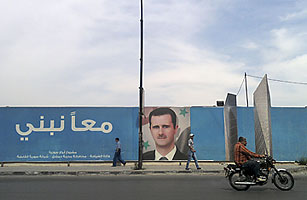
Like many of the syrian farming communities near Lebanon’s northern border, Aarida, as seen from the Lebanese village of Buqaya, offers a bucolic scene worthy of a postcard. Willow trees trail their drooping branches through a stream that winds past plots of ripening strawberries and golden fields of wheat. A small stone bridge, topped by a Syrian flag snapping in the breeze, shelters a family of bullfrogs whose chatter lays the sound track for an early-summer calm. Three weeks ago, that peace was shattered by the screams of Aarida’s women as they poured across the bridge, wailing that their husbands and sons, who had gone out to protest against the regime of Syrian President Bashar Assad, were being attacked by Syrian troops. Soon residents of Buqaya heard approaching gunfire, and the air was filled with the scents of burning houses and fields. Hassan Syed, a Lebanese who lives in Buqaya, watched the horror unfold from his side of the river. That night, he estimates, some 3,000 Syrians fled to Buqaya seeking refuge. Thousands more from other violence-racked Syrian towns crossed over the next day, wading through the hip-deep water when the bridge was closed. Then Syrian border guards started shooting at anybody trying to get across by any means. “Now no one crosses the river,” says Syed, 25. As we talk, a flicker of movement across the stream catches his attention. A sniper watches from a barricade, his gun pointed in our direction. We move behind a bullet-pocked wall. Most of Aarida’s residents fled, Syed explains to me; in their wake arrived busloads of soldiers and thugs. Syed watched as they ransacked the homes of antiregime protesters, loading up on looted washing machines, ovens and refrigerators. They trampled the strawberry fields and stole cattle. Nobody is quite sure where they took their captives. “In Syria, the prisons are so full, they are putting men in stadiums and schools,” says Syed — an allegation backed by refugee accounts and human-rights-monitoring organizations. “That regime is a brutal killer with no respect for anyone.” The Syrian government maintains that the protests, now in their third month, are an armed Islamist uprising. It denies the widespread reports of torture, including the case of a 13-year-old boy whose battered and castrated corpse was returned to his family a month after he was picked up at a protest by security forces. But cumulative accounts from eyewitnesses, refugees and video footage clandestinely uploaded to the Internet point to evidence of a scorched-earth policy that has so far claimed more than 1,000 lives, according to Ammar Qurabi of Syria’s National Organization for Human Rights. More than 10,000 have been detained. The tough line not only precludes hope for reconciliation but also sets the stage for the very chaos and sectarian strife the regime warns will roil the country should it collapse. It is not just Syrian lives at stake. The country, with 22 million people in an area slightly larger than North Dakota, is a pivotal linchpin in a volatile region. Should Syria shatter, it could profoundly destabilize neighbors Iraq and Jordan. Civil war could ignite sectarian conflict in Lebanon and Turkey, which, like Syria, have several religious minorities. Home to the leader of Hamas and a sponsor of Hizballah, Syria also guards the Golan Heights, occupied since 1967 by Israel. If threatened, the regime in Damascus could encourage Hamas and Hizballah to attack the Jewish state. And were Syria to collapse entirely, it could turn into a battleground for militias supported by the region’s major powers: Shi’ite Iran and Sunni Saudi Arabia. These dire scenarios may not yet be inevitable, but their likelihood increases each week as mostly nonviolent protesters face down the brutal regime. Predictions are dangerous, cautions the regional director of an international think tank, who asked not to be identified by name. “Still, I think it’s safe to say that things will never go back to the way they were,” he says. For the moment, protests have largely been limited to rural areas and the suburbs of major cities — demonstrations in central Damascus and Aleppo were immediately, and viciously, smothered. As long as Assad’s urban base stays on the sidelines, says the think-tank director, “the regime could hang on for months. But if Damascus moves, it’s game over.”
Read “Syria’s Embattled Dissidents Grapple with Government Hackers, Wiretappers and Imposters.”
See TIME’s special report: The Middle East in Revolt.